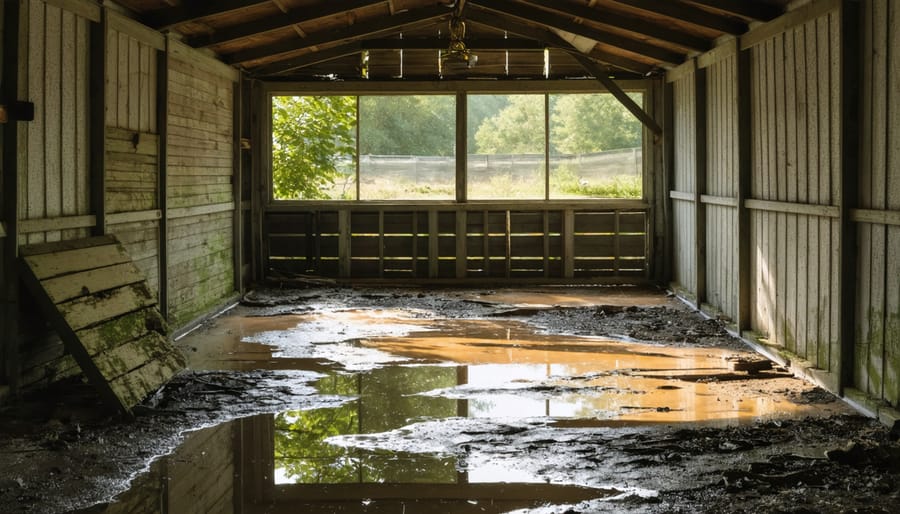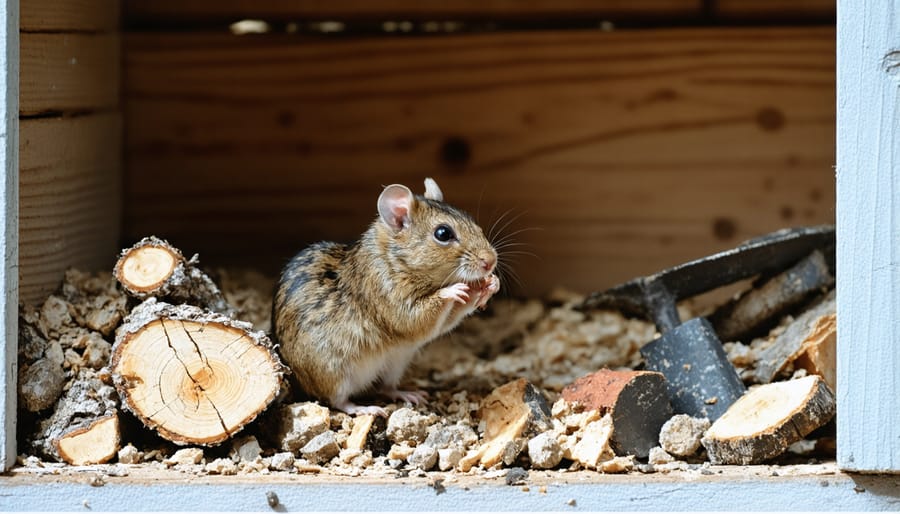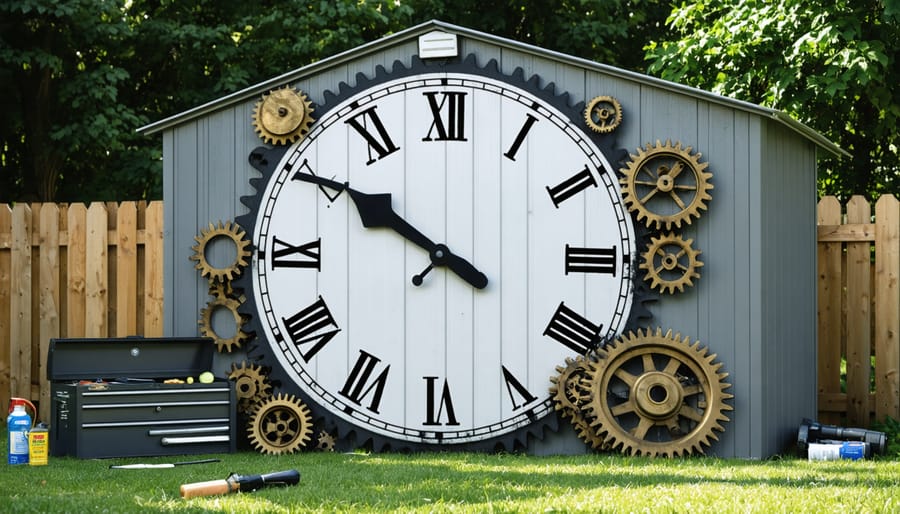Monitor your shed regularly for signs of wear, damage, or pest activity. Inspect the roof, walls, floor, doors, and windows at least twice per year.
Create a simple maintenance log to track inspections, repairs, and preventative upkeep like resealing or repainting. Note dates and specifics.
Address issues promptly to prevent them from worsening. Repair roof leaks, seal gaps, replace rotted wood, and evict pests at the first sign of trouble.
Protect your shed with annual treatments like exterior sealant, pest control, and rust-proofing metal components. An ounce of prevention saves major headaches later.
The Costly Consequences of Neglecting Shed Maintenance
Structural Damage from Leaks and Rot
Left unchecked, moisture can wreak havoc on your shed’s structural integrity. Water seeping in through a leaky roof or poor ventilation creates the perfect breeding ground for rot and mold. Over time, this moisture damage weakens wooden framing, leading to sagging roofs, warped walls, and compromised foundations. Rust can also take hold on metal components like hinges and fasteners. Regular inspections are key to catching leaks early before extensive repairs are needed. Look for telltale signs like water stains, musty odors, or soft spots in the wood. Proactive maintenance, such as resealing the roof and improving ventilation, can go a long way in protecting your shed from the insidious effects of moisture. Don’t let a small leak turn into a major headache – stay vigilant and address any issues promptly to keep your shed standing strong for years to come.
Pest and Rodent Infestations
A poorly maintained shed can quickly become a haven for pests and rodents seeking shelter. Mice, rats, and insects are attracted to dark, damp spaces with easy access to food sources. Even small gaps or cracks in the shed’s exterior provide an open invitation for these unwanted guests. Once inside, they can cause significant damage by chewing through wiring, insulation, and stored items. Rodents also pose health risks as carriers of diseases. To prevent infestations, regularly inspect your shed for signs of pests, such as droppings or gnaw marks. Seal any openings, keep the area clean and dry, and avoid storing food or pet supplies in the shed. If you suspect an infestation, act quickly to remove the pests and repair any damage. Implementing a consistent maintenance routine is key to keeping your shed pest-free and protecting your valuable belongings.
Key Areas to Monitor for Shed Health
Foundation and Flooring
Here are some key signs of foundation and flooring deterioration to watch for in your shed:
Cracks in the concrete slab or blocks can indicate shifting, erosion, or structural issues. Fill small cracks with masonry caulk. For larger cracks, consult a professional.
Soft or spongy areas on wood floors signal rot from moisture intrusion. Replace affected boards and keep water out to prevent further damage.
Sagging or uneven floors usually mean joists or supports have weakened. Add support posts or sister new joists to level things out.
Gaps between the floor and walls let in moisture, pests, and drafts. Seal with expanding foam or caulk.
Musty smells, staining, and warped flooring are red flags for water infiltration. Find and fix the source of leaks, then repair damaged areas. Regular inspections can catch problems early and save on costly repairs later.

Walls and Siding
Regular visual inspections of your shed’s walls and siding can help you spot potential issues before they turn into costly repairs. Look for signs of damage, such as cracks, holes, or warping. Pay close attention to areas around windows and doors, as these are common points of vulnerability. Check for any signs of pest activity, like holes or droppings, which could indicate a more serious infestation. Examine the siding for signs of rot, decay, or peeling paint, which may require prompt attention to prevent further deterioration. By catching these problems early, you can take swift action to fix them and maintain the structural integrity of your shed. Remember to also prioritize preventing rust on any metal components to extend their lifespan.

Roof and Gutters
Regularly inspecting your shed’s roof and gutters is crucial for maintaining its structural integrity and preventing costly repairs. Check for any signs of leaks, holes, or corrosion that could allow water to penetrate and damage the interior. Ensure the roof is securely fastened and that there are no missing or loose shingles. Proper roof maintenance involves cleaning debris from the surface and applying a protective coating if needed. Pay attention to the gutters, confirming they are free of clogs and properly directing water away from the shed’s foundation. If you notice any issues, address them promptly to avoid more extensive damage down the line. By staying vigilant and proactive with your shed’s roof and gutters, you can ensure it remains a safe and reliable storage solution for years to come.
Doors, Windows, and Vents
Properly sealed doors, windows, and vents are crucial for maintaining your shed’s energy efficiency and keeping pests at bay. Regularly inspect these openings for any gaps, cracks, or signs of wear and tear. Replace weatherstripping and caulk as needed to ensure a tight seal. If you notice any damage to the frames or hardware, make repairs promptly to prevent further deterioration. Consider installing screens on windows and vents to allow for ventilation while keeping insects out. By staying on top of these simple maintenance tasks, you can help your shed remain comfortable and pest-free for years to come.
Implementing Your Shed Maintenance Monitor
Setting up a shed maintenance monitor is easier than you might think! First, create a simple checklist of key areas to inspect regularly, such as the roof, walls, doors, windows, and foundation. Aim to check these spots at least once a quarter, or more frequently if you live in an area with harsh weather conditions.
Next, establish a record-keeping system that works for you. This could be a physical notebook, a spreadsheet on your computer, or even a note-taking app on your phone. Each time you conduct an inspection, jot down the date, any issues you noticed, and actions taken or planned.
During your inspections, keep an eye out for signs of wear and tear, such as:
– Cracks or holes in the roof or walls
– Loose or missing shingles
– Peeling paint or rust on metal components
– Warped, sticking, or sagging doors
– Broken windows or damaged weatherstripping
– Puddles or damp spots near the foundation
If you spot any problems, address them promptly to prevent further damage. This might mean making repairs yourself or hiring a professional, depending on the issue and your DIY skills.
Remember, a little bit of regular upkeep can go a long way in extending the life of your shed. By catching and fixing minor issues early, you can avoid costly repairs down the road and keep your shed looking and functioning its best for years to come. Plus, with a maintenance record at your fingertips, you’ll always know when it’s time for the next check-up or repair.
Conclusion
By implementing a proactive maintenance monitoring system for your backyard shed, you can prevent costly repairs and extend the life of your valuable storage space. Regular inspections and timely maintenance not only keep your shed functional but also preserve its appearance, ensuring it remains an attractive addition to your property for years to come.
Catching minor issues early on, such as small leaks or pest infestations, can save you significant time and money down the road. A well-maintained shed provides a safe and secure environment for your belongings, giving you peace of mind and the confidence to store your most treasured items.
Investing a little effort into a shed maintenance routine is a smart choice for any homeowner. By following the tips outlined in this article and staying vigilant, you can avoid the headaches and expenses associated with major shed repairs. Start your maintenance monitor today and enjoy the benefits of a well-cared-for backyard shed. Your future self will thank you for the proactive steps you take now to ensure your shed remains a valuable asset to your home.





Leave a Reply